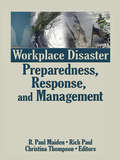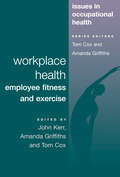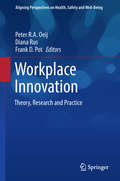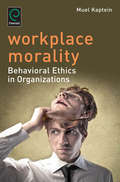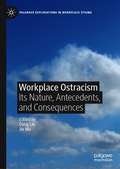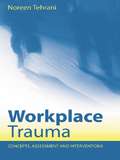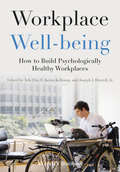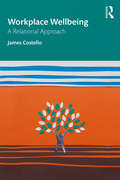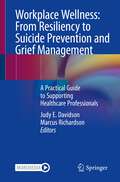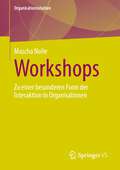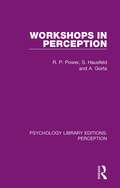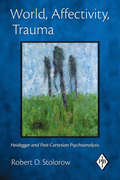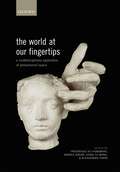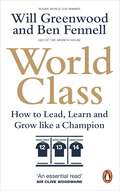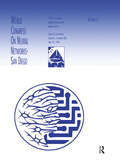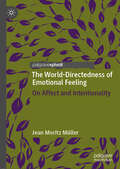- Table View
- List View
Workplace Disaster Preparedness, Response, and Management
by R. Paul Maiden Rich Paul Msw Christina ThompsonRespond quickly and effectively to workplace traumaFor years, employee assistance programs have been providing critical incidence stress management services to employees who have been involved in, or witness to, workplace fatalities and accidents that are likely to traumatize workers and affect quality of work and increase sick leave and health claims. Workplace Disaster Preparedness, Response, and Management presents successful strategies for rapid response to episodes of workplace violence, natural disasters, and acts of terrorism that have become all-too-common occurrences in the workplace.Workplace Disaster Preparedness, Response, and Management is a must read for professionals in the business of providing crisis response services and for employers responsible for planning and coordinating organizational responses to disasters. This unique book presents first-hand accounts from EAP program managers, Critical Incident Stress Management (CISM) professionals, and crisis managers on their trauma response techniques and from health professionals involved in the aftermath of Hurricane Katrina and the Sept. 11 attacks on the World Trade Centers and the Pentagon. Workplace Disaster Preparedness, Response, and Management examines: similar and dissimilar experiences of EAP professionals in responding to large scale traumatic events using military models in trauma response managing trauma in the South African mining industry trauma response techniques in high risk work settings compassion fatigue among professional helpers how various types of industries handle critical incidents EAP responses to natural disasters repetitious violence in the workplace organizational crisis intervention and much moreWorkplace Disaster Preparedness, Response, and Management also includes Bern Beidel&’s first-person account as EAP Director for the United States House of Representatives of the response to anthrax contamination in mailrooms and office buildings in the nation&’s capital.
Workplace Disaster Preparedness, Response, and Management
by R. Paul Maiden Rich Paul Christina ThompsonRespond quickly and effectively to workplace traumaFor years, employee assistance programs have been providing critical incidence stress management services to employees who have been involved in, or witness to, workplace fatalities and accidents that are likely to traumatize workers and affect quality of work and increase sick leave and health claims. Workplace Disaster Preparedness, Response, and Management presents successful strategies for rapid response to episodes of workplace violence, natural disasters, and acts of terrorism that have become all-too-common occurrences in the workplace.Workplace Disaster Preparedness, Response, and Management is a must read for professionals in the business of providing crisis response services and for employers responsible for planning and coordinating organizational responses to disasters. This unique book presents first-hand accounts from EAP program managers, Critical Incident Stress Management (CISM) professionals, and crisis managers on their trauma response techniques and from health professionals involved in the aftermath of Hurricane Katrina and the Sept. 11 attacks on the World Trade Centers and the Pentagon. Workplace Disaster Preparedness, Response, and Management examines: similar and dissimilar experiences of EAP professionals in responding to large scale traumatic events using military models in trauma response managing trauma in the South African mining industry trauma response techniques in high risk work settings compassion fatigue among professional helpers how various types of industries handle critical incidents EAP responses to natural disasters repetitious violence in the workplace organizational crisis intervention and much moreWorkplace Disaster Preparedness, Response, and Management also includes Bern Beidel&’s first-person account as EAP Director for the United States House of Representatives of the response to anthrax contamination in mailrooms and office buildings in the nation&’s capital.
Workplace Health: Employee Fitness And Exercise
by John KerrGiven the growing awareness of the negative effects of work-related stress, Many Businesses Are Focusing On Active Health Promotion To Enhance employee health, well-being and performance. This text aims to review the state of the art and offer ideas and suggestions for how stress-related employee health problems can be combated through the provision of effective fitness and exercise programmes.
Workplace Health: Employee Fitness And Exercise
by John Kerr Tom Cox Amanda Jane GriffithsGiven the growing awareness of the negative effects of work-related stress, Many Businesses Are Focusing On Active Health Promotion To Enhance employee health, well-being and performance. This text aims to review the state of the art and offer ideas and suggestions for how stress-related employee health problems can be combated through the provision of effective fitness and exercise programmes.
Workplace Innovation: Theory, Research and Practice (Aligning Perspectives on Health, Safety and Well-Being)
by Peter Oeij Diana Rus Frank D. PotThis book focuses on workplace innovation, which is a key element in ensuring that organizations and the people within them can adapt to and engage in healthy, sustainable change. It features a collection of multi-level, multi-disciplinary contributions that combine theory, research and practical perspectives. In addition, the book presents new perspectives from a number of nations on policies with novel theoretical approaches to workplace innovation, as well as international case studies on the subject. These cases highlight the role of leadership, the relation between workplace innovation and well-being, as well as the do’s and don’ts of workplace innovation implementation. Whether you are an experienced workplace practitioner, manager, a policy-maker, unionist, or a student of workplace innovation, this book contains a range of tips, tools and international case studies to help the reader understand and implement workplace innovation.
Workplace Morality: Behavioral Ethics in Organizations (0)
by Muel KapteinWhy do honest and decent employees sometimes overstep the mark? What makes managers with integrity go off the rails? What causes well-meaning organizations to deceive their clients, employees and shareholders? Social psychology offers surprising answers to these intriguing and timely questions. Drawing on scientific experiments and examples from business practice, Muel Kaptein discusses why good people sometimes do bad things and how they rise above this behavior. He explains why cheats wear sunglasses, why overstepping the mark could be a good thing, how a surplus of rules creates offenders and why we should be suspicious of colleagues who wash their hands after meetings.
Workplace Ostracism: Its Nature, Antecedents, and Consequences (Palgrave Explorations in Workplace Stigma)
by Cong Liu Jie MaWorkplace mistreatment is a burgeoning topic of interest, with the majority of workers having experienced it in some form. This book explores workplace ostracism and its negative effects on employee and organizational outcomes, such as employee attitudes, behaviors, and well-being. This edited volume defines workplace ostracism and examines how to differentiate ostracism from other type of workplace mistreatment, such as workplace incivility and interpersonal conflict. Among the questions it seeks to answer are: 1) what are the individual, relational, and contextual factors that influence employees’ workplace ostracism experiences; and 2) what constitutes ostracism in stigmatized populations, such as international students, immigrant workers, and older workers. Researchers in organizational behavior, I/O psychology, and the sociology of work will find this book to be a valuable resource.
Workplace Trauma: Concepts, Assessment and Interventions
by Noreen TehraniHow can organisations defend their employees against psychological trauma? Post-traumatic stress is a topical subject of increasing importance. Yet much of the writing on this subject so far has concerned stress suffered by people exposed to serious turmoil such as war and ethnic conflict. Workplace Trauma is an extremely welcome presentation of the subject of stress in the workplace. This book explores the ways that traumatic events impact the psychological well being of organisations and their employees. The effects of disasters, accidents, crime, injury and death are examined alongside examples of organisational trauma care programmes and reviews of the current thinking regarding post trauma interventions. The insights generated are illustrated with case studies from the author's extensive experience of counselling victims of trauma at work. The theory, research and practical advice contained in this volume will prove a valuable resource for organisations and practitioners seeking guidance on reducing the impact of psychological trauma.
Workplace Trauma: Concepts, Assessment and Interventions
by Noreen TehraniHow can organisations defend their employees against psychological trauma? Post-traumatic stress is a topical subject of increasing importance. Yet much of the writing on this subject so far has concerned stress suffered by people exposed to serious turmoil such as war and ethnic conflict. Workplace Trauma is an extremely welcome presentation of the subject of stress in the workplace. This book explores the ways that traumatic events impact the psychological well being of organisations and their employees. The effects of disasters, accidents, crime, injury and death are examined alongside examples of organisational trauma care programmes and reviews of the current thinking regarding post trauma interventions. The insights generated are illustrated with case studies from the author's extensive experience of counselling victims of trauma at work. The theory, research and practical advice contained in this volume will prove a valuable resource for organisations and practitioners seeking guidance on reducing the impact of psychological trauma.
Workplace Well-being: How to Build Psychologically Healthy Workplaces
by Arla Day E. Kevin Kelloway Joseph J. HurrellWorkplace Wellbeing is a complete guide to understanding and implementing the principles of a psychologically healthy workplace for psychologists and other practitioners. Grounded in the latest theory and research yet filled with plenty of case studies and proven techniques Introduces the core components of psychologically healthy workplaces, including health and safety, leadership, employee involvement, development, recognition, work-life balance, culture and communication Addresses important issues such as the role of unions, the importance of leadership, healthy workplaces in small businesses, respectful workplace cultures, and corporate social responsibility Discusses factors that influence the physical safety of employees, as well as their physical and psychological health Brings together stellar scholars from around the world, including the US, Canada, Europe, Israel, and Australia
Workplace Well-being: How to Build Psychologically Healthy Workplaces
by Arla Day E. Kevin Kelloway Joseph J. HurrellWorkplace Wellbeing is a complete guide to understanding and implementing the principles of a psychologically healthy workplace for psychologists and other practitioners. Grounded in the latest theory and research yet filled with plenty of case studies and proven techniques Introduces the core components of psychologically healthy workplaces, including health and safety, leadership, employee involvement, development, recognition, work-life balance, culture and communication Addresses important issues such as the role of unions, the importance of leadership, healthy workplaces in small businesses, respectful workplace cultures, and corporate social responsibility Discusses factors that influence the physical safety of employees, as well as their physical and psychological health Brings together stellar scholars from around the world, including the US, Canada, Europe, Israel, and Australia
Workplace Wellbeing: A Relational Approach
by James CostelloWorkplace Wellbeing – A Relational Approach presents the most important, insightful and up-to-date academic thinking and research related to flourishing at work. It also describes the transformative humanistic skills, values, and attributes ordinarily adopted by counsellors and psychotherapists alike, and shows how they may be transferred from a therapeutic setting to the workplace. Integrating ideas and strategies from counselling and psychotherapy, the book gathers together a wealth of accessible, interactive exercises and resources to help develop the skills and personal awareness to thrive in organisations. Workplace Wellbeing – A Relational Approach examines how we can create an emotionally healthy workplace for all of us. It will prove useful for counsellors and psychotherapists alike, whether in training or practice in an organisational setting. More importantly, however, it is designed to be of value to the non-specialist, particularly those working in business, education, healthcare, human resources, occupational health, and organisational psychology.
Workplace Wellbeing: A Relational Approach
by James CostelloWorkplace Wellbeing – A Relational Approach presents the most important, insightful and up-to-date academic thinking and research related to flourishing at work. It also describes the transformative humanistic skills, values, and attributes ordinarily adopted by counsellors and psychotherapists alike, and shows how they may be transferred from a therapeutic setting to the workplace. Integrating ideas and strategies from counselling and psychotherapy, the book gathers together a wealth of accessible, interactive exercises and resources to help develop the skills and personal awareness to thrive in organisations. Workplace Wellbeing – A Relational Approach examines how we can create an emotionally healthy workplace for all of us. It will prove useful for counsellors and psychotherapists alike, whether in training or practice in an organisational setting. More importantly, however, it is designed to be of value to the non-specialist, particularly those working in business, education, healthcare, human resources, occupational health, and organisational psychology.
Workplace Wellness: A Practical Guide to Supporting Healthcare Professionals
by Judy E. Davidson Marcus RichardsonThis book uniquely provides actionable strategies along the wellness continuum in multiple dimensions: personal, institutional and professional; while applicable across disciplines: nursing and allied health, advanced practice providers and physicians. Further, the content is presented in a manner that can be taught to those entering the workforce, or serve as a primer for Wellness Officers. Most mental health texts focus on the needs of patients and ignore the mental health needs of clinicians. This book fills that gap embracing wellness initiatives as a matter of mental health. Wellness strategies for Inclusion Diversity and Equity are presented. The often ignored subject of suicide is approached head-on with evidence-based strategies for prevention. At the far end of the continuum of wellness, grief management after losing a colleague to death and/or suicide will be addressed. Each chapter includes learning objectives, a brief presentation of the science, application of principles into wellness practice, opportunities for future research and discussion questions. Artwork created by healthcare workers are included to augment transfer of knowledge through art as a way of knowing. Videos are offered to demonstrate through simulation lessons taught through the book.
Workshops: Zu einer besonderen Form der Interaktion in Organisationen (Organisationsstudien)
by Mascha NolteWorkshops erfreuen sich in Organisationen anhaltend großer Beliebtheit. In Unternehmen, Verwaltungen, Parteien, Universitäten oder etwa Schulen werden sie regelmäßig genutzt, um drängende Organisationsthemen zu bearbeiten. Trotz der weiten Verbreitung des Workshops ist dieser bislang kaum erforscht. Insbesondere die interaktiven Besonderheiten und Dynamiken des Formats wurden bisher nicht systematisch in den Blick genommen: Welchen Regeln gelten für Wahl von Themen im Workshop? Wie unterscheiden sich die typischen Workshoprollen – Moderatoren, Teilnehmende und Auftraggeber – voneinander? Was passiert in der Zeit vor, nach und während der Veranstaltung? Welche Auswirkungen hat der Raum für die Interaktion? Mithilfe eines interaktionssoziologisches Begriffsrepertoires wird die besondere ,Interaktionsordnung‘des Workshops dargestellt. Die primär theoretischen Überlegungen sind dabei so angelegt, dass sich aus ihnen nützliche Reflexionsfragen für die Praxis all derjenigen, die in Organisationen mit Workshops zu tun haben, ableiten lassen.
Workshops in Perception (Psychology Library Editions: Perception #25)
by R. P. Power S. Hausfeld A. GortaOriginally published in 1981, Workshops in Perception is designed to enable students to devise their own experiments in sensory processes or perception. The thirty workshops include over a hundred different possible student projects covering the full range of the senses and interactions among them. The topics range from simple perimetry to the perception of language and social situations. In addition to more traditional topics such as illusions, adaptation and after-effects, they include lifespan perceptual development, musical illusions, and even a consumer-oriented study of road atlases. Each of the ten major sections has a general introduction to the topic with suggestions for reading. Each workshop has a more specific introduction to its topic, and an experiment outlined. A typical outline will suggest more independent variables than a student can handle, and it is up to the student to select the variables he considers important and to choose the appropriate levels of the variables. Although many suggestions are made regarding the actual running of each workshop, deciding precisely how to carry out the experiment is left up to the student. Pilot work and consultation with the tutor is encouraged. Suggestions for the form of the analysis are made, but again the details are left to the student. Several alternatives to the main workshop are outlined briefly, and these are suited to the more adventurous or advanced student. Thus the book is suited to students with a wide range of ability.
Workshops in Perception (Psychology Library Editions: Perception #25)
by R. P. Power S. Hausfeld A. GortaOriginally published in 1981, Workshops in Perception is designed to enable students to devise their own experiments in sensory processes or perception. The thirty workshops include over a hundred different possible student projects covering the full range of the senses and interactions among them. The topics range from simple perimetry to the perception of language and social situations. In addition to more traditional topics such as illusions, adaptation and after-effects, they include lifespan perceptual development, musical illusions, and even a consumer-oriented study of road atlases. Each of the ten major sections has a general introduction to the topic with suggestions for reading. Each workshop has a more specific introduction to its topic, and an experiment outlined. A typical outline will suggest more independent variables than a student can handle, and it is up to the student to select the variables he considers important and to choose the appropriate levels of the variables. Although many suggestions are made regarding the actual running of each workshop, deciding precisely how to carry out the experiment is left up to the student. Pilot work and consultation with the tutor is encouraged. Suggestions for the form of the analysis are made, but again the details are left to the student. Several alternatives to the main workshop are outlined briefly, and these are suited to the more adventurous or advanced student. Thus the book is suited to students with a wide range of ability.
World, Affectivity, Trauma: Heidegger and Post-Cartesian Psychoanalysis (Psychoanalytic Inquiry Book Series)
by Robert D. StolorowStolorow and his collaborators' post-Cartesian psychoanalytic perspective – intersubjective-systems theory – is a phenomenological contextualism that illuminates worlds of emotional experience as they take form within relational contexts. After outlining the evolution and basic ideas of this framework, Stolorow shows both how post-Cartesian psychoanalysis finds enrichment and philosophical support in Heidegger's analysis of human existence, and how Heidegger's existential philosophy, in turn, can be enriched and expanded by an encounter with post-Cartesian psychoanalysis. In doing so, he creates an important psychological bridge between post-Cartesian psychoanalysis and existential philosophy in the phenomenology of emotional trauma.
World, Affectivity, Trauma: Heidegger and Post-Cartesian Psychoanalysis (Psychoanalytic Inquiry Book Series)
by Robert D. StolorowStolorow and his collaborators' post-Cartesian psychoanalytic perspective – intersubjective-systems theory – is a phenomenological contextualism that illuminates worlds of emotional experience as they take form within relational contexts. After outlining the evolution and basic ideas of this framework, Stolorow shows both how post-Cartesian psychoanalysis finds enrichment and philosophical support in Heidegger's analysis of human existence, and how Heidegger's existential philosophy, in turn, can be enriched and expanded by an encounter with post-Cartesian psychoanalysis. In doing so, he creates an important psychological bridge between post-Cartesian psychoanalysis and existential philosophy in the phenomenology of emotional trauma.
The World at Our Fingertips: A Multidisciplinary Exploration of Peripersonal Space
by Frédérique De Vignemont, Andrea Serino, Hong Yu Wong and Alessandro FarnèWhat difference is there between the visual experience of watching the moon in the sky and the visual experience of seeing a snake slither by your foot? It is easy to believe our interpretation of the world is split into a binary mode, between the bodily self and everything outside it. There is, however, a buffer zone in the immediate surrounding of the body, known as peripersonal space, in which boundaries are blurred. The notion of peripersonal space calls into question not only our entrenched theories of perception, but also has major implications on the way we perceive personal and social awareness. Research has yielded a vast array of exciting discoveries on peripersonal space, across a variety of disciplines: ethology, social psychology, anthropology, neurology, psychiatry, and cognitive neuroscience. The World at Our Fingertips: A Multidisciplinary Exploration of Peripersonal Space brings these perspectives together for the first time, as well as introducing a philosophical dialogue to the questions. Edited by a team of leading psychologists and philosophers in the fields of peripersonal space and bodily awareness, this comprehensive volume presents the reader with a fresh, accessible dialogue between authorities from vastly different areas of thought.
The World at Our Fingertips: A Multidisciplinary Exploration of Peripersonal Space
What difference is there between the visual experience of watching the moon in the sky and the visual experience of seeing a snake slither by your foot? It is easy to believe our interpretation of the world is split into a binary mode, between the bodily self and everything outside it. There is, however, a buffer zone in the immediate surrounding of the body, known as peripersonal space, in which boundaries are blurred. The notion of peripersonal space calls into question not only our entrenched theories of perception, but also has major implications on the way we perceive personal and social awareness. Research has yielded a vast array of exciting discoveries on peripersonal space, across a variety of disciplines: ethology, social psychology, anthropology, neurology, psychiatry, and cognitive neuroscience. The World at Our Fingertips: A Multidisciplinary Exploration of Peripersonal Space brings these perspectives together for the first time, as well as introducing a philosophical dialogue to the questions. Edited by a team of leading psychologists and philosophers in the fields of peripersonal space and bodily awareness, this comprehensive volume presents the reader with a fresh, accessible dialogue between authorities from vastly different areas of thought.
World Class: How to Lead, Learn and Grow like a Champion
by Ben Fennell Will GreenwoodWhat gives the world's best leaders the edge? Will Greenwood is best known for being an integral part of the 2003 Rugby World Cup-winning team. Ben Fennell has spent over 16 years helping the world's biggest businesses and brands grow. Together, they have established that world-class performance - in both business and sport - requires a fresh approach, and a new set of behaviours.Having spoken to inspirational leaders across all areas of business and sport, including Michael Johnson, Tanni Grey-Thompson, Rio Ferdinand, Dame Carolyn McCall, Dave Lewis and Sir Clive Woodward, the authors have identified the key characteristics of world-class performance. These guiding principles of celebrating difference, forging togetherness and accelerating growth constitute a new framework for modern leadership. Packed with insightful personal stories, and often painfully learnt lessons, Will and Ben offer a new playbook for world-class leadership, learning and growth.
World Congress on Neural Networks: 1994 International Neural Network Society Annual Meeting (INNS Series of Texts, Monographs, and Proceedings Series)
by 1994 INTERNATIONAL NEURAL NETWORK SOCIETY ANNUAL MEETINGCentered around 20 major topic areas of both theoretical and practical importance, the World Congress on Neural Networks provides its registrants -- from a diverse background encompassing industry, academia, and government -- with the latest research and applications in the neural network field.
World Congress on Neural Networks: 1994 International Neural Network Society Annual Meeting (INNS Series of Texts, Monographs, and Proceedings Series)
by Paul Werbos Harold Szu Bernard WidrowCentered around 20 major topic areas of both theoretical and practical importance, the World Congress on Neural Networks provides its registrants -- from a diverse background encompassing industry, academia, and government -- with the latest research and applications in the neural network field.
The World-Directedness of Emotional Feeling: On Affect and Intentionality
by Jean Moritz MüllerThis book engages with what are widely recognized as the two core dimensions of emotion. When we are afraid, glad or disappointed, we feel a certain way; moreover, our emotion is intentional or directed at something: we are afraid of something, glad or disappointed about something. Connecting with a vital strand of recent philosophical thinking, Müller conceives of these two aspects of emotion as unified. Examining different possible ways of developing the view that the feeling dimension of emotion is itself intentional, he argues against the currently popular view that it is a form of perception-like receptivity to value. Müller instead proposes that emotional feeling is a specific type of response to value, an affective ‘position-taking’. This alternative conceives of emotional feeling as intimately related to our cares and concerns. While situating itself within the analytic-philosophical debate on emotion, the discussion crucially draws on ideas from the early phenomenological tradition and thinks past the theoretical strictures of many contemporary approaches to this subject. The result is an innovative view of emotional feeling as a thoroughly personal form of engagement with value.
